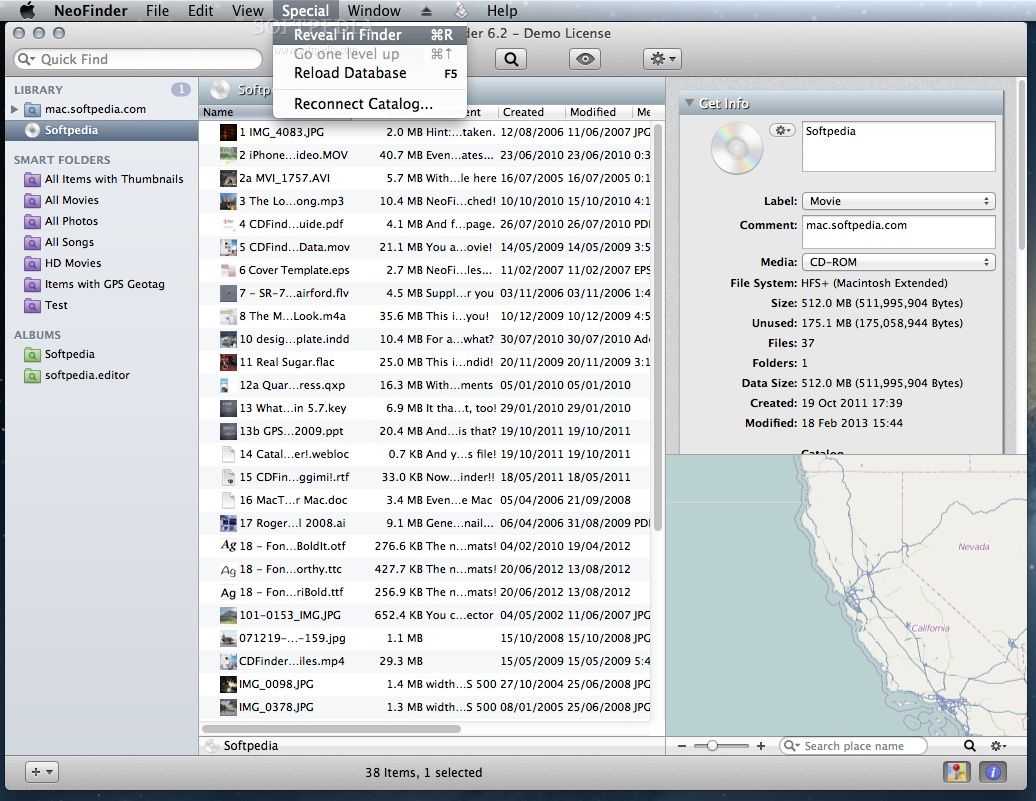

NEOFINDER FIND DATABASE SOFTWARE
Mind you, the NeoFinder app must be running for this to work there’s no system extension or anything to listen in the background - and potentially cause software conflicts.įile cataloguing always comes with things you don’t expect.
NEOFINDER FIND DATABASE UPDATE
As the AutoUpdater is flexible, you can set the database to update every minute if that’s what you wish. That means that, if you remove a file in the Finder, the automatic updater will remove the pointer at a set time and date in the database as well.

With a database, not so much, but the Business licence of NeoFinder has an elegant solution that gives you the best of both worlds: it has a schedule-based AutoUpdater that will scan the folders that correspond to the catalogue automatically. The disadvantage of Photo Mechanic’s approach is that you can’t view your images remotely without having the actual files on a server the advantage is that if you move or delete images from your system in the Finder, the changes are instantly reflected in the application. In contrast, for example, Photo Mechanic 6 doesn’t create file pointers, it allows you to navigate Finder folders and add metadata - loads of the stuff, as per the requirements of fashion and commercial photographers and photojournalists - but that’s it. NeoFinder 7 creates a database of file pointers. The app will also catalogue images from Apple’s Photos, Adobe’s Lightroom, from iPhoto and Aperture. For example, you can import catalogues (sometimes as XML, sometimes as Text-only) from other apps, including Canto Cumulus, Extensis Portfolio, Delicious Library, Broken Cross Disk Manager for Windows, Advanced Disk Catalog for Windows, iView MediaPro, Phase One Media Pro, DiskCatalogMaker, etc. Except for the capability to run this software as a database front-end serving multiple Macs, it comes with features that I remember having seen only in enterprise-scale Digital Asset Management systems. So, I have literally millions of files on thirteen hard disks stored in two locations (or three if you count the cloud).įinally, since I’m a firm believer in redundant backups, I also keep backup copies of everything I’ve just mentioned (and more) on 6 hard disks I store in a safe deposit box and update every couple of months.NeoFinder may look like it’s a simple app, but it’s far from simplistic.
NEOFINDER FIND DATABASE MAC
My Almost Perfect RegimenĪfter three decades of fine-tuning, my regimen includes Time Machine for hourly backups of all disks connected to my Mac Carbon Copy Cloner for bootable clones and duplicating local disks for offsite storage and Backblaze, for backing up to the cloud in real time. Overall, the system is almost perfect, but there’s been one thing missing: a master catalog of all of the millions of files-the ones stored locally, in my safe deposit box, and in the cloud. While macOS’s Spotlight is great at what it does, it’s limited to disks mounted on your Mac. So it’s kinda useless for disks that aren’t mounted or stored elsewhere. The best I could do until recently was print a screen shot of the disk’s contents and tape it to the disk. NeoFinder (formerly CD Finder) to the Rescue!Ī couple of weeks ago I discovered an app called NeoFinder (formerly known as CD Finder) and it’s everything I hoped for and more. It took a couple of days to index all 13 disks. But after that part finished, I could search for any file on any disk and find it (or its offsite location) in a few seconds. I’d be happy if that were all it did, but it does more. It comes with a bunch of useful smart folders like all items with thumbnails all movies all photos all files with 5-star ratings and so on. This NeoFinder Smart Folder displays all of my five star images from 11 disks. You can also create smart folders based on your own criteria. And, you can create albums to consolidate files from different disks in one place. There are also previews, filters, and other useful features to help you find what you seek. Neofinder find database update#Īnd it’s fast and easy to update indexes. Its database is nearly 30GB, but that seems a small price to pay for the ability to locate any file on any disk almost instantly. If you’re the type that has a pile of little storage devices-thumb drives, SD cards, and so on… NeoFinder can index these storage devices (and much more). …NeoFinder could index them in a flash (pun intended). Here’s a tip: If you do index your thumb/flash drives, number the little suckers for easy identification. Since I don’t care what’s on those little things, I don’t do that (if it was important, I copied it a hard disk long ago).


 0 kommentar(er)
0 kommentar(er)
